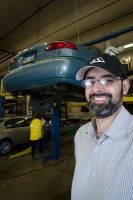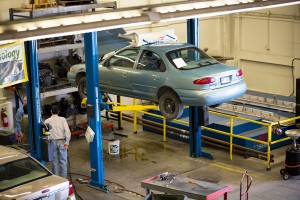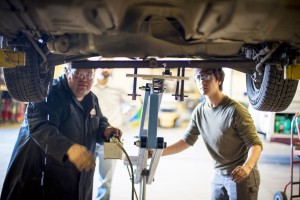UAA creates a virtual-reality driving simulator for Alaska's challenging conditions
by Kathleen McCoy |
You know the scenario: The first significant snowfall in October and everyone still wants to get to work on time. Last winter's black ice is a distant memory, erased by weeks and weeks of unstoppable northern light, warm weather and ice-free pavement.
It's as if we forget everything we ever knew about safely maneuvering in sub-optimal conditions, typical for Alaska. Inevitably, highway medians and roadside ditches are littered with spinouts. We count them on our commute and report the number, proud not to be among them... this time.
What if we could fix that? How would we fix that?

Ghulam Bham, a civil engineering professor, is leading a team of mechanical and electrical engineers to develop a driving simulator out of the 1996 Ford behind him. He and Kenrick Mock of computer science won Innovate money to build it for research purposes at UAA. (Photo by Ted Kincaid/University of Alaska Anchorage)
That's goal number one for Ghulam Bham, a UAA civil engineering professor originally from Karachi, Pakistan, specializing in traffic.
He arrived at UAA in 2012 after earning a master's and doctorate from the University of Illinois, Urbana-Champaign. He's researched driver understanding of traffic signs, and how well real-time message signs reporting traffic conditions ahead influence drivers, among other projects. Ongoing research interests continue to be traffic modeling and driver behavior. Alaska's road conditions offer him significant challenges.
Of course, Karachi, with 23 million residents, and a density of almost 16,000 people per square mile, is no piece of cake. Just imagine that traffic! Did it turn him into a traffic engineer? "I don't even drive in Karachi," he said, laughing. "Because there are no rules there!
Rather, his passion comes from childhood. "I used to play with cars as a kid, and I still do. Now I've taken it to the highest level-the dynamics of traffic."
He plans to take a half dozen engineering and computer science students with him this year, as together they build a driving simulator from the ground up. He plans to have it up and running by fall semester, to be used by students to better design an Alaska-specific highway.
"I would like to see how extreme parameters affect vehicle dynamics," Bham said. "Like, say, driving at high speed and then suddenly hitting a patch of black ice on a banked road." (Translation: Your morning commute next winter.)
The simulator will also be available for social science research, such as effects of texting while driving or combating sleepiness at the wheel. Bham plans to partner with state and national agencies on research they need done.

The donated 1996 Ford sedan loses its motor to accommodate computers and sensors needed to turn the old vehicle into a driving simulator. (Photo by Ted Kincaid/University of Alaska Anchorage)
He and computer science professor Kenrick Mock won funding to build the simulator through UAA's Innovate fund, seed money for research that may lead to publications and patents.
Software and design work has been ongoing for six months, but just this week, the team got the actual car they'll remake into a simulator, a non-descript light turquoise 1996 four-door sedan donated by Continental Auto Group.
By Wednesday, the Ford was up on a rack at the Automotive and Diesel Technology (ADT) garage at UAA, a technical school where 45 students a year move through coursework to become mechanics.
(Side note: If you want job security, here's one to consider. According to Kelly Smith, ADT's director, the average age of mechanics across the country is 53; employers are hungry for the next generation. "Our biggest problem is getting them to come back for year two" of the associate's degree, Smith said; most get hired right into a job after their field practicum.)
Because UAA has a Community and Technical College, where the automotive-diesel program resides, alongside a College of Engineering, circumstances are perfect for savvy mechanics, electrical and mechanical engineering students and their professor to work side-by-side on the project.
But back to that turquoise Ford, where Josh Heppner, a senior in mechanical engineering, stared up at the car's underbelly alongside longtime mechanic and ADT employee Shawn Heusser. Together, their mission was to pull the engine. They had to leave car systems intact enough so gas and brake pedals and the steering wheel could function convincingly, once software and screens projecting traffic scenarios are installed.

Automotive Diesel Technology employee Shawn Heusser, left, and mechanical engineering student Josh Heppner get ready to remove the engine to make room for simulator sensors. (Photo by Ted Kincaid/University of Alaska Anchorage)
An off-the-shelf driving simulator costs $200,000. But building one from the ground up is cheaper, about $30,000, and way more fun. It offers special challenges. Heusser, the mechanic, was already pondering how to recreate tension in the gas pedal: "I'm thinking a hydraulic spring...."
I couldn't get over how much fun Heppner and Heusser were having together inside that engine compartment, or how valuable it is for a young engineering student who plans one day to design next-generation electric cars like the Tesla, to be elbow-to-elbow with a mechanic under the hood of an old Ford.
Two examples: Smith and Heusser voiced the mechanics' frustration over working on engines designed by people who never have to fix them. "We need this one bolt right here," Kelly gestures, "and they've designed all this other stuff on top of it." Take heed, future car designer.
The other was practical. At the end of a long day of wrenching bolts and pulling wires, both Heusser's and Heppner's hands were crusted with thick black grease.
"C'mere," the mechanic said to the engineering student. He grabbed a can of WD40 and sprayed his own hands, and told Heppner to do the same.
"Now rub your hands together," he said. "This is the only way you'll ever get your hands clean." And he was right.
A version of this story by Kathleen McCoy appeared in the Anchorage Daily News on Sunday, June 8, 2014.
 "UAA creates a virtual-reality driving simulator for Alaska's challenging conditions" is licensed under a Creative Commons Attribution-NonCommercial 4.0 International License.
"UAA creates a virtual-reality driving simulator for Alaska's challenging conditions" is licensed under a Creative Commons Attribution-NonCommercial 4.0 International License.














